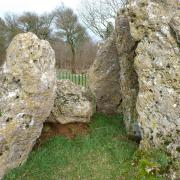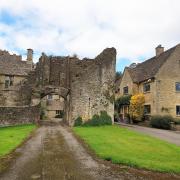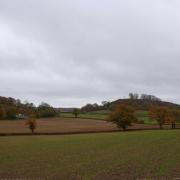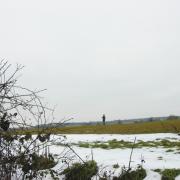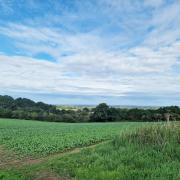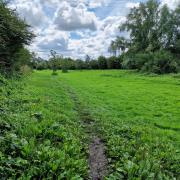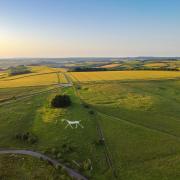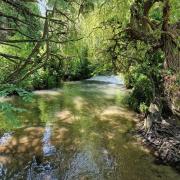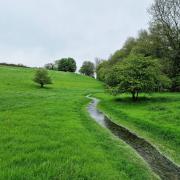A tale of love and loss in medieval times that takes us from Quenington to Oxford and back again
This is a journey from Quenington to Oxford, and back in time to the beginning of the 14th century, the last days of the Knights Templar, and also to the fertile imagination of 19th-century Lechlade schoolteacher and local historian Adin Williams and a sorrowful tale of love, enchantment, and betrayal.

In Quenington today, as you approach the church on Church Road, you can see a huge medieval gateway, which was once the entrance to the Knights Hospitaller preceptory. ‘Knights Hospitallers!’ we hear you cry. ‘You promised the Templars! Far more glamorous what with the Holy Grail and all that!’ Well, it’s complicated, and it’s not surprising that Adin Williams misunderstood what was going on. The Hospitallers, another medieval military religious order, had had a preceptory in Quenington since the 12th century, but the Templars had the running of the adjacent church. But why let that get in the way of a good story? Such concerns wouldn’t have troubled Williams, whose use of the facts was rather elastic in his verse romances and – sadly for his career – in his teaching as well.
He tells how, in 1305, after the fall of Jerusalem, a knight, Sir Aldred, returned from the Holy Land to take up a new life in Quenington, helping to manage all the estates the Templars had in the Cotswolds. His preceptor sent him round to meet the neighbours, and while at the nearby castle of Hatherop, to the northeast of Quenington, he met the beautiful daughter of the house, Mira. It was love at first sight. But he was sworn to celibacy! You can be sure that tragedy awaited. But not quite the way you might expect. The preceptor knew that the Templar order was on its last legs. He hoped the young knight would soon be free to marry the young lady. But such was not be. For she fell ill, a lingering sickness that got a little bit worse every day.
Sir Aldred was desperate. He knew that he would do anything for his lady. The preceptor, seeing his despair, wrote letters to all the other preceptories and granges asking for help. At length, a letter came with news of a means of miracle. A mere 30 miles away on the outskirts of Oxford there was a holy well dedicated to St Winifred and St Margaret, which, the writer said, would cure any ills. Sir Aldred wasted no time. He saddled up his horse and rode off into the night.

The road he would need to take into Oxford took much the same route as the present A40. But first he had to get to it. Quenington is not far from an old Roman road, Akeman Street, which once ran all the way from St Albans to Cirencester and crosses the A40 between Minster Lovell and Witney. Sir Aldred spurred his horse across the Coln, through the woods of the Hatherop estate, today a school, past his beloved’s home, and on to the long straight road heading northeast, towards Oxford and his miracle. If you look at the map, you can chart Akeman Street from minor road by Eastleach Folly, to bridle path, to track, and back to road again, sometimes passable, sometimes not; a lost road, but one that back in the 14th century Sir Aldred could travel.

Along this route today there are only scraps of woodland, but back then there was far more. In the darkness, Sir Aldred’s horse stepped off the path into the trees. Horse and rider blundered further and further from the road until they were in a tangled wildwood. And from the darkness amidst the trees came creatures of nightmare, to taunt, to hurt, to seduce. A woman of frightening beauty with evil in her eyes begged the knight to love her. Sir Aldred’s heart was true, he drew his sword, he spoke Christ’s name, and upon his horse he fled, the fiends of hell hissing and howling close behind him. He did not stop when he reached the Oxford road; he rode on through the night, till at last he came to the ford below Eynsham at Swinford and there crossed the Thames. He could see by the dim light of dawn the spires and roofs of Oxford arrayed within the city walls.

He made his way into the city through the west gate, on the Botley Road, near the castle, then through the city centre and out by the east gate on the High Street. Then he proceeded round the walls to the parish of Holywell, where the church of St Cross still stands. He slid down from his exhausted horse and stared about. Here was a little village green, ahead the church, squat and broad, and next to it the manor house. The holy well of St Winifred and St Margaret lay between the two. The manor house you see today was rebuilt in the 15th century by Merton College, which has owned much of the parish since the late 13th century. Today, Holywell Manor and the well in its grounds are owned by Balliol College, but the place has been a public bath, and also a penitentiary for so-called ‘fallen women’. The well was rediscovered during the conversion from penitentiary to college building in the 1930s and now sits secluded in the Arts and Crafts inspired gardens.

The well-keeper filled Sir Aldred’s bottle full of holy water and sent him on his way. The knight rode back as fast as he had come. In the daylight he kept safely to the road. Night was just falling when he arrived at Hatherop Castle. There he watched his beloved Mira drink the holy water. But his journey had been in vain. Mira died that very night, and Sir Aldred’s heart and mind broke into pieces. He dreamt that the nightmare woman came to him again and told him she had poisoned the bottle and so it was he who had killed his sweetheart. In such despair, he did not long survive her. He was buried in Quenington’s churchyard. You will search in vain for his grave, or any grave of a Templar or Hospitaller. No graves of such antiquity can be seen today. But the little Norman church of St Swithun’s is the one that Sir Aldred would have known, with its Romanesque tympana that show to the south the Coronation of the Virgin and to the north the Harrowing of Hell, both with beasts around them less beautiful than those seen by Aldred – but perhaps a little less scary too!

Essentials
Parking: Road parking in Quenington and Holywell.
Toilets and refreshments: The Keeper’s Arms, Quenington. Many pubs and eateries in Oxford.
Transport links: Quenington isn’t easily reached by public transport. Holywell is in walking distance of Oxford city centre.
Map: OS Explorer 179: Gloucester, Cheltenham & Stroud; Oxford A–Z Pocket Street Map.
Links
Route: gb.mapometer.com/walking/route_5202475
Holywell Manor: www.oxfordhistory.org.uk
Further reading: Gloucestershire Ghost Tales by Anthony Nanson and Kirsty Hartsiotis
Kirsty Hartsiotis and Anthony Nanson are Stroud-based storytellers and writers. Their books include Gloucestershire Folk Tales, Wiltshire Folk Tales, Gloucestershire Ghost Tales, and their new book Gloucestershire Folk Tales for Children. Kirsty is also the curator of decorative and fine art at The Wilson Art Gallery and Museum, Cheltenham. Anthony runs the small press Awen Publications.




